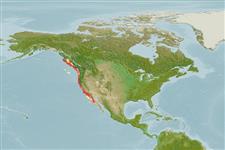Teleostei (teleosts) >
Perciformes/Scorpaenoidei (Scorpionfishes) >
Sebastidae (Rockfishes, rockcods and thornyheads) > Sebastinae
Etymology: Sebastes: Greek, sebastes = august, venerable (Ref. 45335); aurora: From the 'aurora' meaning dawn - referring to the colouring (Ref. 6885).
Eponymy: Aurora was the Roman goddess of the dawn. In the case of the goby, the name refers to the pattern on its caudal fin being ‘…reminiscent of the rising sun’. The name is often applied to species with pink/yellow colouration. (Ref. 128868), visit book page.
More on author: Gilbert.
Environment: milieu / climate zone / depth range / distribution range
Ecology
Marine; bathydemersal; depth range 124 - 769 m (Ref. 27437), usually 366 - 550 m (Ref. 6885). Deep-water; 56°N - 27°N, 135°W - 113°W
Northeast Pacific: Amphitrite Point in Vancouver Island, Canada to Cedros Island, Baja California, Mexico.
Length at first maturity / Size / Weight / Age
Maturity: Lm ?, range 28 - ? cm
Max length : 41.0 cm TL male/unsexed; (Ref. 27437); max. reported age: 75 years (Ref. 55644)
Short description
Identification keys | Morphology | Morphometrics
Dorsal spines (total): 13; Dorsal soft rays (total): 12 - 14; Anal spines: 3; Anal soft rays: 5 - 6. Head spines strong - nasal, preocular, supraocular, postocular, tympanic, parietal and nuchal spines present, coronals usually absent (Ref. 27437). Small lobes projecting from anterior part of upper jaw (Ref. 27437). Second anal fin spine long (Ref. 27437). Rose-red to pink dorsally, silvery on sides and ventrally (Ref. 27437).
Common offshore (Ref. 2850). Viviparous, with planktonic larvae and pelagic juveniles (Ref. 36715). Trawled on soft bottom and when caught scales usually rub off, leaving white pockets bordered by red; also caught in sablefish traps (Ref. 2850).
Eschmeyer, W.N., E.S. Herald and H. Hammann, 1983. A field guide to Pacific coast fishes of North America. Boston (MA, USA): Houghton Mifflin Company. xii+336 p. (Ref. 2850)
IUCN Red List Status (Ref. 130435: Version 2024-2)
Threat to humans
Harmless
Human uses
Fisheries: commercial
Tools
Special reports
Download XML
Internet sources
Estimates based on models
Preferred temperature (Ref.
123201): 4.5 - 7.5, mean 5.4 °C (based on 15 cells).
Phylogenetic diversity index (Ref.
82804): PD
50 = 0.5000 [Uniqueness, from 0.5 = low to 2.0 = high].
Bayesian length-weight: a=0.00389 (0.00180 - 0.00842), b=3.12 (2.94 - 3.30), in cm total length, based on all LWR estimates for this body shape (Ref.
93245).
Trophic level (Ref.
69278): 3.7 ±0.5 se; based on size and trophs of closest relatives
Resilience (Ref.
120179): Very Low, minimum population doubling time more than 14 years (tmax=75; tm=5).
Prior r = 0.03, 95% CL = 0.02 - 0.04, Based on 1 full stock assessment.
Fishing Vulnerability (Ref.
59153): Low to moderate vulnerability (31 of 100).
